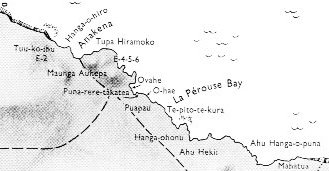Hatu means 'earth', but also 'to unite for a purpose', 'favourable outcome, 'in control', and other seemingly quite disparate meanings:
With interest
we can read of lighting the earth oven for the successful
outcome of an enterprise: He ká i te umu mo te hatu o te
aga. I suppose the gods must be placated. Or that the
spirit of the dead spring 'moa' must return to the sky. Or
that the flames will magically induce also Moon to rise.
A
stone (hatu) does not move, it just sits there. Likewise
is someone sitting crosslegged (noho hatu)
securely anchoraged:

A standing person (tagata)
can illustrate the fully grown
'person', but not a 'newborn' one:
To fold is to make 2 out of 1. Mahatu we have met with as an allusion: 24 ko ehu ko mahatua a piki rangi a hakakihikihi mahina. This 'fold' seems to have the backside (tu'a) as number 2, a fold between the front side and the back side of the island. But the 2 'faces' of Moon also implies there could be a fold somewhere in the middle of the northeastern shore:
This map from Captain Cook's visit to the island in 1774 is illuminating on several points. The steep coast north from where Cook anchoraged leads up to Cabo Norte and from its 'fold' (between waxing Sun and waxing Moon, I would say) the steep coast continues as a broad line on the map, but not beyond Hanga Ohiro:
It suggests Hanga Ohiro marks the end of Waxing Moon, beyond which the high coast ('land') does not continue. 'Land' is corresponding to the waxing phase, first in form of the voracious 'Spring Beast', then as the milder Waxing Moon. Further to the southeast from the bay of Anakena comes Waning Moon, i.e. Anakena lies at Full Moon. Therefore, item 14 should have hatu in its name. The high coast in the northwestern sector of the island represents 'earth' ('ebb', 'summer'). |
|||||||||||||||


